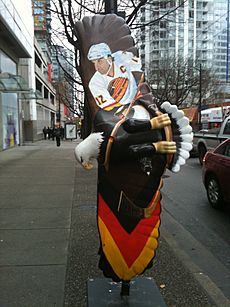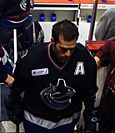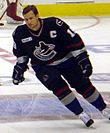History of the Vancouver Canucks facts for kids
The history of the Vancouver Canucks began when the team joined the National Hockey League (NHL). Founded as a new team in 1970, along with the Buffalo Sabres, the Vancouver Canucks were the first NHL team to be based in Vancouver. They took their name from a minor professional hockey team that had played in Vancouver since 1945.
After a tough start as a new team, the Canucks won their first division title in 1975. The team then went through a long period of 16 losing seasons. However, during this time, led by captain Stan Smyl, they made their first trip to the Stanley Cup Finals in 1982. They lost in four straight games to the powerful New York Islanders. Later, after getting important players like Trevor Linden, Pavel Bure, and Kirk McLean, they won division titles in 1992 and 1993. The Canucks reached the Stanley Cup Finals again in 1994, losing in a thrilling seventh game to the New York Rangers. After some average years in the late 1990s, the team got better under captain Markus Naslund in the early 2000s.
Contents
Early Hockey in Vancouver
Vancouver first got a professional ice hockey team in 1911. Two brothers, Frank and Lester, started the Vancouver Millionaires. This team was one of three in the new Pacific Coast Hockey Association. To give the Millionaires a home, the Patrick brothers built the Denman Arena. At the time, it was known as the world's largest rink with artificial ice. The Millionaires played for the Stanley Cup five times, winning it in 1915 against the Ottawa Senators on their home ice. This was the first time a team from the west coast won the Stanley Cup.
After the Millionaires team ended in 1926, Vancouver only had minor league hockey teams for many years. The team that came before today's Canucks, also called the Vancouver Canucks, played from 1945 to 1970 in the Pacific Coast Hockey League and Western Hockey League.
Trying to Join the NHL (1967–1970)
Vancouver wanted to get an NHL team, so they started building a new, modern arena called the Pacific Coliseum in 1967. The minor league Canucks were playing in a smaller arena nearby. A group from Vancouver, led by former mayor Fred Hume, tried to get one of the six new teams that were joining the NHL in 1967. But the NHL said no. Some people thought the decision was unfair, possibly because of rivalries with other Canadian teams.
Less than a year later, the Oakland Seals team was having money problems and not many fans. It looked like they might move to Vancouver. But the NHL didn't want a new team to move so soon, so they stopped the deal. Instead, the NHL promised Vancouver would get a team in the next expansion. A new group, led by Tom Scallen, made a presentation and was given a new team for $6 million. This new ownership group bought the minor league WHL Canucks. The Vancouver Canucks then joined the NHL along with the Buffalo Sabres for the 1970–71 season.
Team History
Starting Out (1970–1982)
To pick players for their first season, the NHL held an Expansion Draft. The Buffalo Sabres won a lottery to pick first in both the Expansion Draft and the regular draft. The Canucks' general manager, Bud Poile, chose defenceman Gary Doak as his first pick. Other players picked by Vancouver included centre Orland Kurtenbach, who became the Canucks' first captain, and defenceman Pat Quinn, who later became the team's general manager and coach. Two days later, the Canucks picked defenceman Dale Tallon as their first-ever player in the regular draft.
At this time, the NHL had East and West Divisions. The "Original Six" teams were in the East, and the newer teams were in the West. But the Canucks, even though they were on the West Coast, were put in the East Division. This meant they played against stronger, older teams, which made it hard to make the playoffs.
The Canucks played their first game on October 9, 1970, against the Los Angeles Kings. They lost 3–1, with defenceman Barry Wilkins scoring the team's first goal. Two days later, they got their first win, beating the Toronto Maple Leafs 5–3.
As expected, the Canucks struggled in their first four seasons and didn't make the playoffs. During this time, Poile built a core of players including Kurtenbach, Tallon, Jocelyn Guevremont, Andre Boudrias, and Dennis Ververgaert. Boudrias was the team's top scorer for four of their first five seasons.
Before the 1974–75 season, the team was sold to local businessman Frank Griffiths for $9 million. The NHL was expanding quickly because of a rival league, the World Hockey Association (WHA), which even had a team in Vancouver, the Vancouver Blazers. The Canucks pushed for a new division setup, arguing they needed to be competitive to attract fans. So, the East Division was changed, and the Canucks moved to the new Smythe Division, which was much easier.
The Canucks then had their first winning season (38 wins, 32 losses, 10 ties) and won their first division title with 86 points. This meant they made the playoffs for the first time. They lost to the Montreal Canadiens in five games. The Canucks easily attracted more fans than the Blazers, and the Blazers team moved to Calgary the next season. The Canucks had another winning season in 1975–76 and made the playoffs, but lost to the New York Islanders.
The Canucks missed the playoffs for the next two seasons. Captain Kurtenbach retired and became a coach. The team had four different captains over the next seven years. After 1976, Vancouver didn't have another winning season for 16 years. However, because the playoff format expanded, the Canucks still made the playoffs nine times during that period. After the 1976–77 season, Jake Milford became general manager. He brought in players like Stan Smyl, Thomas Gradin, and Richard Brodeur, who became key players in the 1980s.
The 1982 Stanley Cup Run
The Canucks made their first big splash in the playoffs in 1982. Before this, they had never won a single playoff series. Even though the Canucks had a losing record in the 1981–82 regular season, they started playing really well at the end of the season. Smyl became the team's leader, taking over as captain. The Canucks then made it all the way to the Stanley Cup Finals by beating the Calgary Flames, Los Angeles Kings, and Chicago Black Hawks.
During the series against the Black Hawks, Vancouver's coach, Roger Neilson, was upset with the referees. He famously put a white towel on a hockey stick and held it up, like he was giving up. The players on the bench did the same thing. At the next game, fans cheered by waving white towels above their heads. This became a famous Canucks tradition called "Towel Power" and is now seen in many sports. The Canucks won that series, reaching the Stanley Cup Finals for the first time ever.
In the Finals, the Canucks played against the New York Islanders, who had won the Stanley Cup the past two years and were much stronger. Vancouver took the first game to overtime, but lost. The Canucks couldn't complete their amazing run and were swept, losing all four games. The 1982 playoffs were the last time Vancouver won a playoff series until 1992.
Tough Times and a Comeback (1982–1994)
After their surprising Stanley Cup run, the Canucks struggled for the rest of the 1980s. Even though it was easy to make the playoffs back then (four out of five teams in their division qualified), the Canucks only made it four times. New players like Patrik Sundstrom and Tony Tanti joined the team and were top scorers. When they did make the playoffs, they were usually knocked out by the Edmonton Oilers or Calgary Flames.
After a few general managers, former Canucks defenceman Pat Quinn became general manager in 1987. He started rebuilding the team, trading older players for younger ones. A big trade sent Sundstrom to the New Jersey Devils for winger Greg Adams and goalie Kirk McLean. The team also got better through the draft. In 1988, they picked winger Trevor Linden second overall. The next year, they made a surprising pick by choosing Russian winger Pavel Bure 113th overall. Many teams thought Bure wasn't eligible to be drafted that year, so it took a year for the NHL to approve his pick.
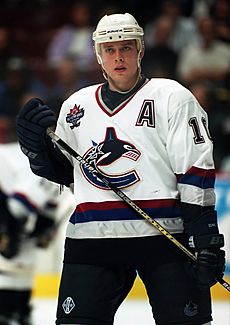
As the 1990s began, Stan Smyl gave up his captaincy in 1990. Trevor Linden became the new captain, the youngest in team history at 21. Smyl retired as the team's all-time leader in games, goals, assists, and points. With Linden leading and Quinn making good trades, the Canucks became strong again in the early 1990s. They won their first division title in 17 years in 1991–92. That season, the Canucks honored Smyl by retiring his number 12 jersey, the first player in team history to have his number retired. In the 1992 playoffs, the Canucks won their first series since 1982, but lost to the Oilers. Quinn won the Jack Adams Award as best coach, and Bure won the award for top rookie. The next year, the Canucks won their division again. Bure became a superstar, scoring 60 goals in back-to-back seasons, which are still team records.
The 1994 Stanley Cup Run
In 1994, the Canucks made their second trip to the Stanley Cup Finals. They entered the playoffs as the seventh team in the Western Conference. Even though they didn't play great in the regular season, the Canucks played very well in the playoffs and had another unexpected run.
They started the playoffs with a tough series against the Calgary Flames. Vancouver came back from being down 3–1 in games to win the series in seven games. Games 5, 6, and 7 were all won in overtime. The deciding Game 7 had two of the most famous plays in Canucks history. In the first overtime, goalie Kirk McLean made an incredible save, known as "The Save," sliding across the crease to stop a shot from Robert Reichel. In the next period, Bure scored on a breakaway to win the series.
After beating the Flames, the Canucks defeated the Dallas Stars and Toronto Maple Leafs (both in five games) to reach their second Stanley Cup Finals. Forward Greg Adams scored a double-overtime goal against the Maple Leafs to send the Canucks to the Finals. In the Finals, the Canucks played against the New York Rangers, who had the best record in the league. Vancouver won Game 1 in overtime, thanks to McLean's amazing 52 saves. But they lost Games 2, 3, and 4. The Canucks then won the next two games to force a Game 7 in New York. Despite two goals from Linden (who was playing with cracked ribs), Vancouver lost the game 3–2.
Changes and New Stars (1994–2001)

With young stars like Linden, Bure, and McLean, the Canucks seemed ready to keep winning after 1994. However, the team didn't have a winning season for the next six years. In 1995, the Canucks played their last game at the Pacific Coliseum and moved into the new General Motors Place (now Rogers Arena) in Downtown Vancouver.
The Canucks made a big move by getting high-scoring Russian forward Alexander Mogilny from the Buffalo Sabres. He joined Bure, who he had played with before. Mogilny became the second player in team history to score 50 goals and 100 points in a season. But Bure got a knee injury, so they didn't play together much. Vancouver missed the playoffs for four seasons in a row. In 1996, another future Canucks star, Markus Naslund, joined the team in a trade. This trade is seen as one of the best in NHL history for the Canucks, as Naslund became the team's all-time leading goal and point scorer years later.
In July 1997, the Canucks signed famous free agent Mark Messier to a three-year deal. Messier was known as a great leader. Linden gave up his captaincy for Messier, a decision he later regretted, feeling Messier caused problems in the locker room. As the team kept losing, general manager Pat Quinn was fired after ten years. Coach Tom Renney was also fired and replaced by Mike Keenan. Keenan made many trades, including trading Linden to the New York Islanders. While fans were upset, the Canucks got winger Todd Bertuzzi in return, who became a very important player for the team later on. After the Canucks finished last in their conference, Brian Burke became the new general manager.
The next year, 1998–99, was the team's worst since 1977–78. Keenan was fired, and Marc Crawford became coach. Pavel Bure, unhappy in Vancouver, was traded to the Florida Panthers. Finishing last again, Vancouver had a high draft pick. General manager Burke made trades to get the second and third overall picks, and he used them to draft Swedish twin forwards Daniel and Henrik Sedin.
The Canucks started to get better in the 1999–2000 season, just missing the playoffs. Mogilny was traded. With Bure gone and Messier leaving, players like Naslund and Bertuzzi started to shine. Naslund was chosen as captain, a role he held for eight years, matching Smyl's record.
The "West Coast Express" Years (2001–2005)
Under general manager Burke and coach Crawford, the Canucks became a playoff team again. They made the playoffs in 2001 and 2002, and then became regular contenders for the Northwest Division title.
During this successful time, captain Markus Naslund and power forward Todd Bertuzzi became top scorers and NHL All-Stars. Joined by center Brendan Morrison in 2001–02, this group was nicknamed the "West Coast Express" by fans and media. For three years, Naslund was one of the top five scorers in the league. Bertuzzi was also a top scorer. General manager Burke also brought back Trevor Linden. The team now had a strong young core with these players, plus defencemen Ed Jovanovski and Mattias Ohlund, and goalie Dan Cloutier.
In 2002–03, the Canucks lost the division title on the last day of the season. Naslund also just missed winning the scoring titles. In the 2003 playoffs, the Canucks won their first playoff series in eight years, beating the St. Louis Blues in seven games. But they lost to the Minnesota Wild in the next round.
The following season, the Canucks were trying to win their first Northwest Division title. On March 8, 2004, during a game against the Avalanche, Todd Bertuzzi was involved in a serious incident. He was suspended by the NHL for his actions. The Canucks went on to win their first Northwest Division title that season. But they lost in the first round of the 2004 playoffs to the Calgary Flames. After this, Burke's contract as general manager was not renewed, and Dave Nonis took over. Because of the NHL lockout, the 2004–05 season was not played. Many Canucks players, like Naslund and the Sedin twins, went to Europe to play.
After the Lockout (2005–2011)
After the NHL lockout ended, new rules were put in place for the 2005–06 season to help skilled players score more. The Canucks were expected to do well, but they missed the playoffs. The "West Coast Express" line didn't score as much. Coach Marc Crawford was fired and replaced by Alain Vigneault. Nonis then traded Bertuzzi, ending the "West Coast Express" era. In return, the Canucks got All-Star goalie Roberto Luongo.

With many changes in 2006–07, the Canucks won the Northwest Division title again. In his first season, Luongo was nominated for top goalie awards and tied for the second-most wins in a season by an NHL goalie. The Canucks started the 2007 playoffs with a very long quadruple-overtime win against the Dallas Stars. It was the longest game in club history. Vancouver won the series in seven games. They then lost to the Anaheim Ducks, who went on to win the Stanley Cup. After the playoffs, coach Vigneault won the Jack Adams Award.
The Canucks struggled in the 2007–08 season due to many injuries and missed the playoffs. The last game of the season was Trevor Linden's final NHL game. After missing the playoffs again, general manager Nonis was fired and replaced by Mike Gillis. Longtime captain Markus Naslund and Brendan Morrison left the team. On May 29, 2008, the Canucks lost young defenceman Luc Bourdon in a motorcycle crash.

With Naslund gone, Gillis announced that Luongo would be the new team captain in September 2008. This was the first time in a long time that a goalie was named captain of an NHL team. That season, the Canucks retired Trevor Linden's number 16 jersey, hanging it next to Smyl's number 12. The Canucks also signed veteran player Mats Sundin. The team won another Northwest Division title and made the playoffs. They swept the St. Louis Blues in the first round (their first four-game sweep ever), but lost to the Chicago Blackhawks in the second round.
In the 2009–10 season, the Canucks had the longest road trip in NHL history because Vancouver was hosting the 2010 Winter Olympics. GM Place was used for ice hockey during the games. Many Canucks players played in the Olympics. Goalie Roberto Luongo and Team Canada won the gold medal against Ryan Kesler and the United States.
When the NHL season continued, Henrik Sedin became the first Canucks player to win the Art Ross Trophy (leading scorer) and the Hart Memorial Trophy (most valuable player). He set a franchise record with 112 points. Vancouver won the Northwest Division title again. They beat the Los Angeles Kings in the playoffs, but were again eliminated by Chicago, who went on to win the Stanley Cup.
40th Anniversary and 2011 Stanley Cup Run
The 2010–11 season started with a ceremony to celebrate the team's 40th anniversary. Henrik Sedin was officially named the team's new captain. The Canucks played the Los Angeles Kings, their first opponent from 1970, and both teams wore their original uniforms. Throughout the season, the Canucks honored past players with a "Ring of Honour" in the arena. Four players were added: Orland Kurtenbach, Kirk McLean, Thomas Gradin, and Harold Snepsts. In December 2010, Markus Naslund's number 19 jersey was also retired.
The Canucks had an amazing season, winning the Western Conference for the first time and also securing the Presidents' Trophy (best regular season record in the NHL). They finished with team records of 54 wins and 117 points. Daniel Sedin won the Art Ross Trophy as the league's leading scorer, making it the first time in NHL history that two brothers won the award in back-to-back years. Ryan Kesler tied Daniel for the team lead in goals. Goalies Roberto Luongo and Cory Schneider won the William M. Jennings Trophy for allowing the fewest goals in the NHL.
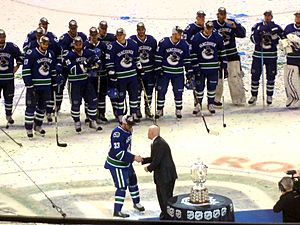
In the 2011 Stanley Cup playoffs, the Canucks faced the Chicago Blackhawks, who had eliminated them the past two years. Vancouver took a 3–0 lead in the series, but Chicago came back to tie it 3–3, forcing a Game 7. In the deciding game, winger Alexandre Burrows scored in overtime to win the series.
In the next round, the Canucks faced the Nashville Predators. Ryan Kesler was a key player, helping the Canucks win in six games. Then, facing the San Jose Sharks in the Conference Finals, captain Henrik Sedin led the team. Vancouver defeated San Jose in five games, with defenceman Kevin Bieksa scoring a double-overtime winner in Game 5.
Reaching the Stanley Cup Finals for the first time since 1994, the Canucks played the Boston Bruins. Vancouver won Game 1 with a late goal from Raffi Torres, and Game 2 in overtime with a goal from Burrows. But when the series moved to Boston, the Bruins tied it with big wins. In Game 5 back in Vancouver, the Canucks won 1–0 to take a 3–2 series lead. With a chance to win the Stanley Cup in Game 6 in Boston, Vancouver lost. In Game 7, the Canucks were shut out 4–0 by the Bruins, losing the series 4–3.
End of an Era
The Vancouver Canucks and Ottawa Senators played in the 2014 Heritage Classic at BC Place.
The Canucks were strong contenders again in the 2011–12 season, winning the Presidents' Trophy for the second year in a row. But in the 2012 playoffs, they were eliminated in five games by the Los Angeles Kings, who went on to win the Cup.
The 2012–13 season was shorter because of a player lockout. The Canucks wore Vancouver Millionaires replica jerseys to celebrate the Millionaires' 100th anniversary.
Vancouver won their fifth straight Northwest Division title, but were swept in the first round of the playoffs by the San Jose Sharks. Coach Vigneault was fired and replaced by John Tortorella.
The Canucks played their first outdoor NHL game on March 2, 2014, against the Ottawa Senators at BC Place. This event was called the 2014 Heritage Classic. During this season, Luongo was traded back to the Panthers. The team failed to make the playoffs for the first time in six years. General manager Gillis was fired, and Trevor Linden became president of hockey operations. Tortorella was also fired after just one season.
The Jim Benning Years (2014–2021)
On May 21, 2014, Jim Benning became the new general manager. On June 23, 2014, Willie Desjardins was named the 18th head coach. The team made many changes: veteran forward Ryan Kesler was traded, and new players like Ryan Miller and Radim Vrbata were signed. That season, the team honored former general manager and coach Pat Quinn, who had passed away. The Canucks finished second in their division and reached 100 points. They faced the Calgary Flames in the first round of the playoffs, losing in six games.
As the team struggled in the 2016–17 season, more veteran players were traded to help rebuild the team. On March 25, 2017, the Canucks' young draft pick Brock Boeser made his NHL debut. Desjardins and his coaching staff were replaced by Travis Green, who had coached their minor league team.
The 2017–18 season was another tough year, but rookie Boeser was a bright spot. He scored 29 goals and 55 points in 62 games, finishing second in voting for rookie of the year. Longtime Canucks stars Daniel and Henrik Sedin played their final game on April 7, 2018. After the season, Trevor Linden stepped down as president of hockey operations.
The 2018–19 season saw the debut of the Canucks' 2017 first-round draft pick, Elias Pettersson. Pettersson broke the Canucks' rookie scoring record with 66 points, leading all NHL rookies, and won the Calder Trophy for rookie of the year.
The team celebrated its 50th season in the NHL, the 2019–20 season, with a ceremony. Bo Horvat was named the 14th captain in team history. The 2019–20 season also saw the rookie year of defenceman Quinn Hughes, who finished second in Calder voting. On February 12, 2020, Daniel and Henrik Sedin's numbers 22 and 33 were retired. On March 12, 2020, the NHL season was stopped due to the COVID-19 pandemic. The Canucks won their first playoff series in nine years in the 2020 Qualifying Round, beating the Minnesota Wild. They then defeated the St. Louis Blues but were eliminated by the Vegas Golden Knights in seven games.
General manager Jim Benning, head coach Travis Green, and others were fired on December 5, 2021, after a slow start to the season. On the same day, Bruce Boudreau became the 20th head coach of the Canucks.
The Jim Rutherford Era (2021–Present)
On December 9, 2021, Jim Rutherford was named president of hockey operations and interim general manager. He then hired Patrik Allvin as the new general manager on January 26, 2022.



